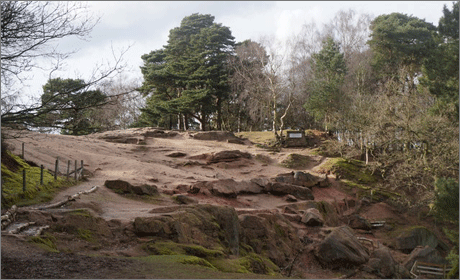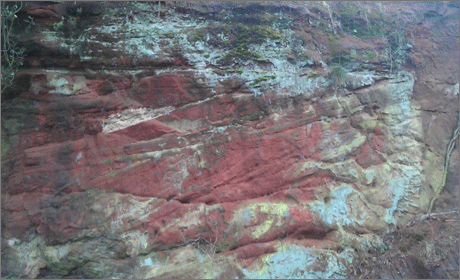Alderley Edge, Cheshire

Stormy Point, Alderley Edge: © Mike Pennington
Alderley Edge is located in Cheshire in England and is one of the classic locations in the UK for Triassic age (the Triassic period is from ~252 to 202 million years ago) sandstones. This site sits within the Cheshire Basin and is studied for the Triassic red-bed fluvial (river-deposited) and aeolian (wind-deposited) sandstone sequences. Like the Vale of Eden, the Cheshire Basin is also a fault-bounded half-graben containing up to 4.5km of Permo-Triassic sediments. The red-bed deposits found at Alderley Edge are associated with non-marine depositional environments either in alluvial floodplains or semi-arid deserts. The red colour is due to the presence of oxidised iron, thus indicating deposition in oxidising conditions, rather than more reducing conditions found in seawater.
The sediments found at Alderley edge show a wide range of sedimentary structures such as lamination, ripple-bedding, desiccation structures and cross-bedding with a range of water-escape structures. The aeolian cross bedding indicate wind directions from the east, as is currently seen in the sediments found in modern-day Sahara rather than the prevailing wind direction of today which is from the west. This indicates that either the prevailing wind directions have
changed over geological time or that the British continent has moved. We know from evidence at other geological sites that the
| |

|
| |
Dune cross bedding: © Pete Loader
|
continents and plates have moved a great deal over geological time and so evidence of alternative wind directions in the sediments at Alderley Edge point towards Britain having migrated over time through the movement of the plates.
This site is also one of the primary sites for studying natural gas and petroleum reservoirs as it is an analogue for the petroleum reservoirs found in the Southern North Sea and the East Irish Sea. Over 60 mineral species have been recorded in the area with the mines were worked principally for copper, lead and cobalt ores.
The geology makes this a site of unique importance for scientific and educational purposes and it deserves its status as a Geological SSSI.
Twinned with: Navajo Sandstone, United States
The Navajo sandstone is estimated to cover 400,000 km2 of the western United States and is found spread across the states of Nevada, Arizona, Colorado and Utah as part of the Colorado Plateau. The formation consists of thick layers of highly-angled cross-bedded sandstones, just like those found at Alderley edge. The rocks are predominantly composed of rounded quartz grains and were formed in a vast ancient desert of sand dunes, or erg, similar to the modern Sahara Desert....continue reading